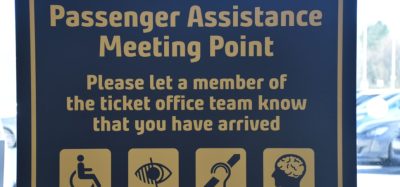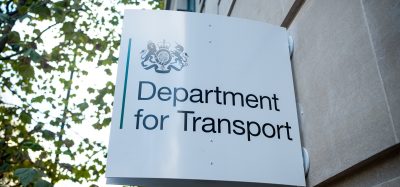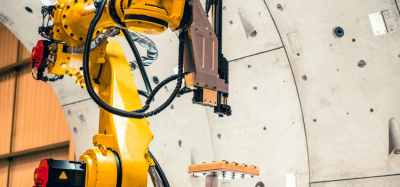Reducing level crossing numbers and improving safety records in Portugal
Posted: 20 July 2014 | Paulo Soares de Melo | No comments yet
Accidents at level crossings are, recognisably, a global problem that must be issued by a vast number of stakeholders – from rail and road sides, from private to public sectors. It is estimated that between 600,000 and 1,000,000 level crossings exist in the world. In Europe there are approximately 114,000 level crossings, which amounts to a density of five per 10km of railway line. What work is the Portuguese railway infrastructure manager doing to reduce the number of crossings on its network and therefore reducing the number of fatalities? Paulo Soares de Melo, Head of the Level Crossings Department at REFER, explains more.
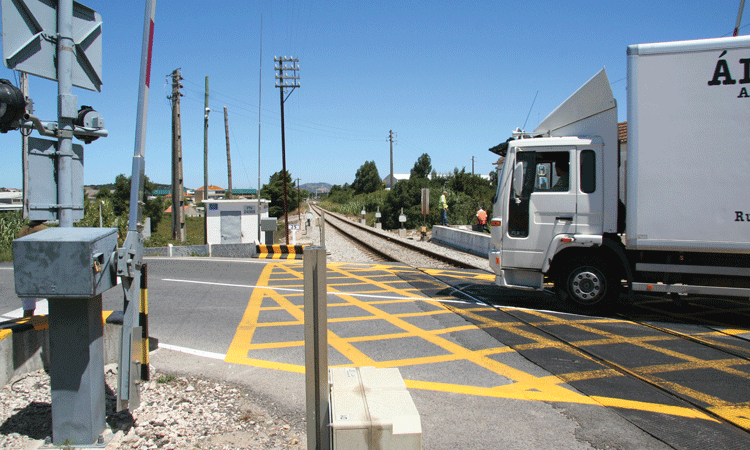

In 2012 in Europe alone, it was reported that more than 700 people were killed or seriously injured in a total of 573 significant accidents. These represent approximately 30% of all fatalities on the railways but less than 1% of road fatalities. These disturbing numbers, and the fact that almost all of the accidents resulted from transgression or distraction from the level crossing user, should encourage us to share experiences and good practices, as well as promote awareness campaigns alerting to the risk of crossing the railways and the necessary compliance with safety rules.
In Portugal, the strong growth in traffic recorded from the 1980s, as well as the set increase in train speed, significantly contributed to the increase of risks at level crossings and it became necessary to create conditions to reduce those risks.
2,494 in 1999
In 1999 the Portuguese railway network, with about 2,800km of lines, had 2,494 level crossings, which amounted to nine level crossings per 10km of railway line, and only 26% of them had active protection systems, i.e., were automatic or guarded by railway staff. In the same year 154 accidents occurred that resulted in 28.2 FWI (fatalities and weighted injuries).
Therefore, in December 1999, a new law-decree was published, which introduced a new policy on level crossings that was based on the following four main pillars:
- Prohibition to establish new level crossings – all new railway crossings had to be underpasses or overpasses
- Determines that railway and road network managers had to plan the removal of the higher risk level crossings
- Determines the installation of protective equipment on level crossings, in relation to the road and rail traffic moments and train speeds
- Determines the obligations and responsibilities of rail and road infrastructure managers, rail operators and level crossing users.
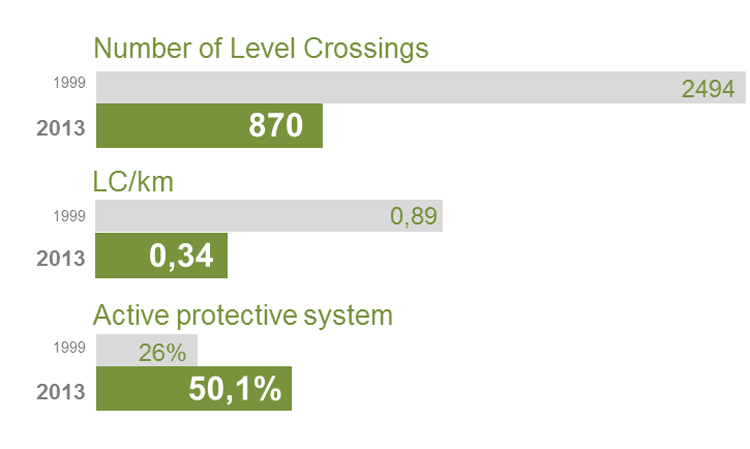

Achievements from 1999 to 2013
The strategy was to reduce the number of existing level crossings and the objective was to reach the European reference value of density of level crossings in the network.
An initial goal was established – to reduce the density of nine level crossings per 10km to a density of just five by 2006. An intense programme of level crossings closures was implemented which resulted in the closure of 1,173 by 2005 – a reduction of 46% on the number of level crossings. That corresponded to a density of 4.8 per 10km, thus accomplishing the objective one year in advance.
Alongside the closure programme, an upgrade of level crossings’ equipment was also in place, helping to increase the protection level at approximately 300 sites.
Short of expectations
However, besides the significant reduction of the number of accidents achieved by 2005 – 72 occurred which was a reduction of 53% – it still fell short of expectations and it was therefore decided that the strategy and objectives should be redefined.
The new strategy put in place was a new level crossing management system based on a risk model with the objective to reduce the number of accidents. The focus was then shifted onto the higher risk crossings and to mitigate the risk drivers. New medium- and long-term goals were set for 2009 and 2015 – to reduce by half the number of accidents recorded in 2004, and to reduce by 60% the number of accidents recorded in 2006, respectively.
A risk analysis approach was implemented and a tool was developed based on an algorithm tailor-made for the specifications and characteristics of level crossings on the Portuguese network. This tool identifies the risk drivers and risk levels for each crossing, as well as permitting cost benefit analysis, therefore enabling the application of adequate mitigation measures, based on consistent risk and economic criteria. This approach enabled REFER to concentrate the available resources on the higher risk level crossings and on the specific risk drivers of each level crossing.
Therefore, while maintaining the programme of closures of level crossings, other actions were executed, such as upgrading passive level crossings or those only with lights and bells to automatic with half barrier ones, or the use of obstacle detection systems in level crossings with four half barriers.
There were also low-cost solutions developed in-house that, in some specific cases, can reduce up to a third of the cost of a regular automatic half barrier level crossing.
In parallel, different solutions and technologies were implemented on bells, lights and pavements, and on solutions that made the level crossings more visible or improved the flow of road and pedestrian traffic, or even aspects that would make it easier and faster for the general public to communicate to REFER’s operations centre on an incident or accident at a level crossing.
Involving road infrastructure managers
One crucial factor was the involvement of road infrastructure managers that enabled partnerships, which in turn resulted in responsibilities and costs distribution, as well as better road layouts near level crossings.
REFER has continuously maintained an awareness campaign called ‘Pare, Escute, Olhe’ (which translates into Stop, Listen, Look) since 2009. This campaign has the objective of promoting good practices and alerting people to the risk of unsafe behaviours at level crossings. The campaign uses several means such as TV, radio, newspapers, internet and social networks.
REFER has participated in all six International Level Crossing Awareness Days. The 2014 event brought together 43 countries from all continents, with a special focus on professional drivers. The event was held in Lisbon, with a coordinated effort by REFER and UIC, where almost 100 people participated in the international conference and roundtable discussions. The importance of road safety was approached by several speakers from different countries, from road and rail, and also with the perspective from the police forces, the municipalities and the media. The international conference, which had high level representatives from REFER and UIC, was closed in a press conference by the Portuguese State Secretary for Transport, Infrastructures and Communications.
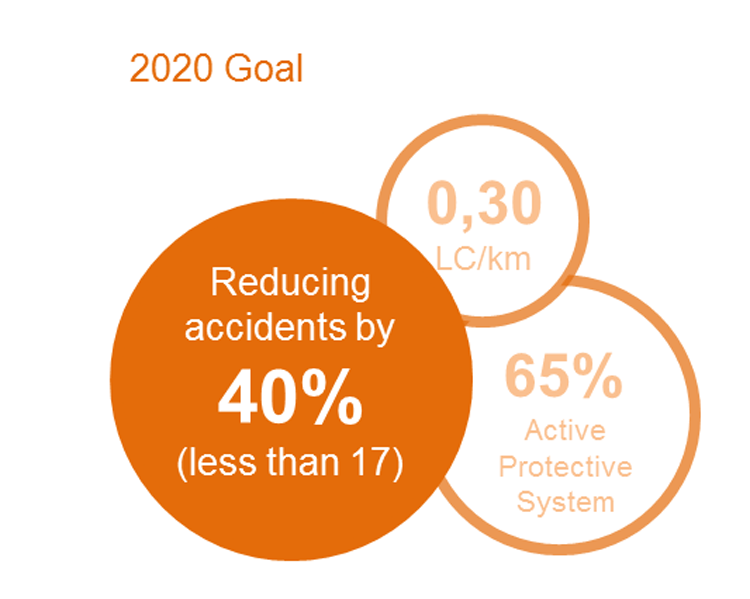

The goal to achieve by 2020
Between 1999 and 2013, REFER reduced the number of level crossings from 2,494 to just 870, achieving a density now of 3.4 level crossings per 10km of railway line, plus the majority of level crossings now have active protective systems, when in 1999 it was only 26%, with a total investment of €345 million.
The goal set for 2009 was reached – in that year 49 accidents occurred – the goal was to achieve less than 52.
Long-term goal
Furthermore, the long-term goal set for 2015 is to achieve less than 29 accidents which has been surpassed already by four years – from 2011 to 2013 the number of accidents have been constantly less than 29 – for instance in 2013, only 27 was recorded.
REFER’s integrated and systematic approach over the last 14 years has resulted in a reduction of 65% of the number of level crossings, an increase on the number of level crossings with active protection systems and, more importantly, a reduction of 83% of the number of accidents.
However, because we feel that much more can still be done, REFER has set a new challenging goal for 2020. We have a target to further reduce the number of accidents by 40%, i.e. to achieve less than 16 accidents by 2020. This is now the new objective driving us forward.
A new programme of closures and upgrades is already in progress (called the ‘Plan 2014-2020’) to reduce the number of level crossings to a density of just three level crossings per 10km of railway line and to also increase the percentage of level crossings with active protective systems to 65%.
We will also reinforce an awareness campaign starting in late-2014 targeted for children and teenagers – the ‘School Programme’ will see REFER interact directly with students and teachers at several schools.
The implementations of this strategy, as well as the involvement and cooperation of other institutions and stakeholders, will be crucial in shaping the success on years to come.





